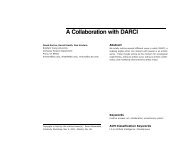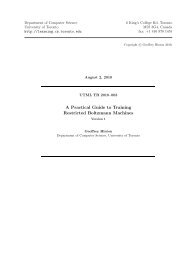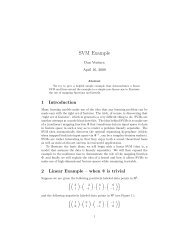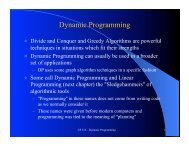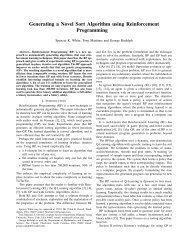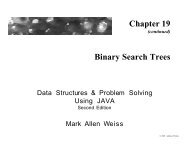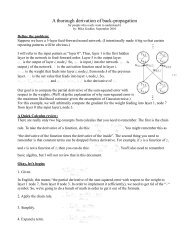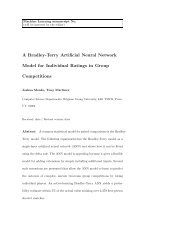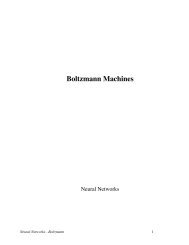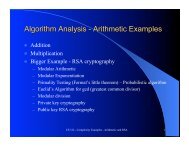Norton - Neural Networks and Machine Learning Lab - Brigham ...
Norton - Neural Networks and Machine Learning Lab - Brigham ...
Norton - Neural Networks and Machine Learning Lab - Brigham ...
Create successful ePaper yourself
Turn your PDF publications into a flip-book with our unique Google optimized e-Paper software.
Preparing More Effective Liquid State <strong>Machine</strong>s Using Hebbian<br />
<strong>Learning</strong><br />
David <strong>Norton</strong> <strong>and</strong> Dan Ventura<br />
Abstract—In Liquid State <strong>Machine</strong>s, separation is a critical<br />
attribute of the liquid—which is traditionally not trained. The<br />
effects of using Hebbian learning in the liquid to improve<br />
separation are investigated in this paper. When presented with<br />
r<strong>and</strong>om input, Hebbian learning does not dramatically change<br />
separation. However, Hebbian learning does improve<br />
separation when presented with real-world speech data.<br />
S<br />
I. INTRODUCTION<br />
PIKING recurrent neural networks (neural microcircuits)<br />
have powerful representational power due to the<br />
complex time dimension of the network. Spiking neurons<br />
closely emulate biological neurons by transmitting signals in<br />
the form of spike trains where each spike has constant<br />
amplitude. Information is encoded in the varying<br />
frequencies of spikes produced by the neurons rather than<br />
the single rate value commonly used in non-spiking<br />
networks [1]. Spiking neural networks can convey temporal<br />
information more accurately by maintaining non-uniform<br />
spiking frequencies. In addition, the recurrent property of<br />
neural microcircuits allows for input acquired previously in<br />
time to change how later input affects the network.<br />
Unfortunately, the additional computational abilities of the<br />
network result in more variables which complicate the<br />
training of the network. The recurrent properties of neural<br />
microcircuits further obscure the networks so that only very<br />
simple neural microcircuits have been successfully trained.<br />
In an attempt to exploit the power of very complex neural<br />
microcircuits, the liquid state machine (LSM) [2][3], was<br />
invented. The liquid state machine consists of two major<br />
components: the liquid <strong>and</strong> the reading function. An input<br />
signal (Fig. 1a) is introduced into the liquid in the form of<br />
spike trains (Fig. 1b). This instigates a pattern of spikes<br />
throughout the neurons in the liquid (Fig. 1c) which is<br />
allowed to persist for a set duration. In this paper the<br />
duration is always the length of the input spike train. The<br />
spiking neurons are recorded as a state vector (Fig. 1d) at set<br />
intervals determined by a sampling rate. Each of these state<br />
vectors can be thought of as a snap shot of the current state<br />
of the liquid. Once the state vector(s) have been collected,<br />
they are passed as input to the reading function (Fig. 1e)<br />
which performs the task of classifying the input. [4]<br />
Intuitively, the liquid state machine can be compared to<br />
electroencephalography in which a device measures brain<br />
activity <strong>and</strong> creates EEGs (electroencephalograms) that<br />
contain information about the state of the brain. This<br />
information can provide insight into how the brain interprets<br />
any sensory stimulus it may have been experiencing at the<br />
time the EEG was recorded. In this example, the input into<br />
the liquid is the sensory stimulus that the brain is exposed to.<br />
The liquid is the brain itself <strong>and</strong> the EEGs represent the state<br />
vectors. The reading function is the human or machine that<br />
interprets the EEGs.<br />
The LSM is, in effect, an attempt to avoid the necessity of<br />
training a neural microcircuit. Rather, a r<strong>and</strong>om neural<br />
microcircuit is created in order to change a complex<br />
temporal input space into the spatial domain that traditional<br />
learning algorithms perform well on. This paper investigates<br />
the possibility of actually training the liquid through the use<br />
of Hebbian learning in an attempt to create structure in the<br />
liquid that will allow for a more effective mapping of the<br />
input from the temporal to the spatial domain. Because of<br />
the unsupervised nature of Hebbian learning, the effects of<br />
both r<strong>and</strong>om <strong>and</strong> non-r<strong>and</strong>om input on the Hebbian-trainable<br />
liquid (Hebbian liquid) are explored in this paper. Section<br />
II.A contains a description of how Hebbian <strong>Learning</strong> is used<br />
to mold the neural microcircuit in this paper. Section II.B<br />
defines a method of measuring the effectiveness of neural<br />
microcircuits used as liquids for LSMs. Section III reports<br />
on two experiments: the effects of r<strong>and</strong>om <strong>and</strong> non-r<strong>and</strong>om<br />
input on liquid structure. Finally a discussion of the results<br />
is presented in section IV.<br />
II. METHODS<br />
A. Hebbian <strong>Learning</strong> <strong>and</strong> STDP Synapses<br />
Hebbian learning is often implemented in neural<br />
microcircuits with STDP synapses (spike-time-dependant<br />
plasticity synapses). As with other spiking synapses there is<br />
a weight <strong>and</strong> time delay associated with the synapse. In<br />
addition, the STDP synapse has several other parameters that<br />
are related to how its weight changes as its pre- <strong>and</strong> postsynaptic<br />
neurons fire [3]. The synapse’s weight changes in<br />
David <strong>Norton</strong> <strong>and</strong> Dan Ventura are with the Computer Science<br />
Department, <strong>Brigham</strong> Young University, Provo, UT 84602 USA (email:<br />
ghotikun@hotmail.com, ventura@cs.byu.edu).
Fig. 1 Diagram of a liquid state machine. (a, b) The input signal is transformed into a series of spikes via some function.<br />
(c) The spike train is introduced into the neural microcircuit, or “liquid”. (d) Snapshots of the state of the “liquid” are<br />
recorded in state vectors. (e) The state vectors are used as input to train a learning algorithm, the reading function.<br />
proportion to the temporal correlation between the pre- <strong>and</strong><br />
post-synaptic neurons. If the pre-synaptic neuron fires first,<br />
then the weight is increased; if the post-synaptic neuron fires<br />
first then the weight is decreased. In this way, synapses that<br />
participate in a neuron’s breach of threshold (resulting in a<br />
spike) are strengthened while those that don’t are weakened<br />
[1]. We will refer to an LSM that uses STDP synapses as a<br />
Hebbian Liquid State <strong>Machine</strong> (HLSM).<br />
B. Separation<br />
The effectiveness of an LSM is a function of two<br />
qualities: the approximation <strong>and</strong> the separation of the LSM.<br />
Approximation refers to the reading function’s ability to<br />
classify the state vectors acquired from the liquid.<br />
Separation refers to “the amount of separation between<br />
trajectories of internal states of the system that are caused by<br />
two different input streams” [5]; or in other words, the<br />
ability of the liquid to produce discernibly different patterns<br />
when given different classes of inputs. Since any machine<br />
learning algorithm can be used for the reading function, this<br />
paper focuses on improving the separation attribute of the<br />
LSM.<br />
In order to measure the separation of a liquid we use the<br />
following definition presented first by Goodman [6]:<br />
N N Cm<br />
( Oi<br />
) − Cm<br />
( O<br />
j<br />
)<br />
2<br />
Sep(Ψ , O)<br />
= ∑∑<br />
2<br />
i= 1 j= 1 N<br />
where Ψ is a neural microcircuit (or liquid), O is a set of<br />
state vectors, <strong>and</strong> N is the total number of output classes<br />
represented by O. O is divided into N subsets each of which<br />
contains all elements of O belonging to a common output<br />
class. The center of mass, C for each subset is calculated<br />
m<br />
as follows:<br />
∑ o<br />
j<br />
o j ∈O<br />
C<br />
m<br />
( Oi<br />
) =<br />
O<br />
i<br />
The Euclidean distance between every pair wise<br />
combination of center of mass vectors is determined. Each<br />
center of mass is the estimate of the representative state<br />
vector for each output class. The ideal liquid would separate<br />
the state vectors for each output class into distinct clusters<br />
within the vector space. Goodman's research indicates that<br />
there is a positive correlation between this separation<br />
measure <strong>and</strong> the accuracy of the LSM [6].<br />
There are certain negative behaviors common in LSMs<br />
that can significantly decrease their separation. These<br />
behaviors are termed pathological synchrony <strong>and</strong> overstratification.<br />
Pathological synchrony occurs when most of<br />
the neurons in the liquid get caught in infinite positive<br />
feedback loops with respect to their firing. These infinite<br />
loops continuously influence the state of the liquid<br />
overriding the flow of information from the input. In<br />
extreme cases the entire liquid can begin firing continuously<br />
in synchrony (see Fig. 2). Such liquids have low separation<br />
because of the loss of pattern associated with such crowded<br />
spiking.<br />
The opposite extreme is over-stratification—when groups<br />
of neurons do not propagate a series of spikes induced by an<br />
input spike long enough. In these cases, input spikes do not<br />
influence each other within the liquid, thus resulting in a loss<br />
of temporal coherency that can be represented by the liquid<br />
(see Fig. 3). Since both of these features are detrimental to<br />
the effectiveness of LSMs, this study emphasizes<br />
eliminating them.<br />
III. RESULTS<br />
Two experiments were performed in order to observe how<br />
Hebbian learning affects the structure <strong>and</strong> separation of<br />
liquids. R<strong>and</strong>om input was introduced into the liquid for the<br />
first experiment while speech data was used as input for the<br />
second experiment. Also, Hebbian learning was compared
to r<strong>and</strong>om weight updates in the first experiment.<br />
A. Effects of R<strong>and</strong>om Input on HLSMs<br />
For this experiment, the effect of a single channel of<br />
r<strong>and</strong>om input on an HLSM’s separation was tested in order<br />
to better underst<strong>and</strong> the dynamics of the HLSM architecture.<br />
Two initial liquid states were explored, a pathological<br />
synchrony state <strong>and</strong> an over-stratification state. These initial<br />
states were selected in order to observe how Hebbian<br />
<strong>Learning</strong> could potentially recover from them. For each<br />
initial state, actual Hebbian learning versus r<strong>and</strong>om weight<br />
updates were compared. Each of these four experiments<br />
employed 100 iterations of training of the liquid. This<br />
training was either Hebbian learning or r<strong>and</strong>om weight<br />
update. For each iteration of training the separation of the<br />
liquid was determined with a set of state vectors, O, of size<br />
100. Each state vector in O was created by introducing a<br />
r<strong>and</strong>omly generated train of 25 spikes over a 1.0 second time<br />
interval, d, as input into the liquid. The state vector was<br />
measured at time d with ε = 1.0 ms. Since the input was<br />
r<strong>and</strong>om, each state vector belonged to a unique output class.<br />
Thus, for this experiment N = O (see section II.B above).<br />
Neurons<br />
Time (sec.)<br />
Fig. 2 Pathological Synchrony. This occurs when most of<br />
the neurons in the liquid get caught in infinite positive<br />
feedback loops with respect to their firing. Dots indicate the<br />
presence of a spike.<br />
Each liquid was prepared with 135 neurons to be<br />
comparable to previous research [7]. The input was encoded<br />
as a spike train from a single input neuron. Future research<br />
will exp<strong>and</strong> the number of input neurons used. The<br />
remainder of the settings were chosen based on a series of<br />
preliminary experiments <strong>and</strong> reflect the best results obtained<br />
in those trials. The connection probability from the input<br />
neuron to the other inter-neurons was 0.1 while the<br />
probability of connection between the inter-neurons was<br />
0.05. The mean delay for the synapses of the liquid was 10<br />
ms with a st<strong>and</strong>ard deviation of 1 ms. For the liquids<br />
initiated in a pathological synchrony state, the mean weight<br />
−7<br />
value for synapses was set at 1× 10 while the mean weight<br />
value in liquids initiated in an over-stratification state<br />
−8<br />
was 8 × 10 . The st<strong>and</strong>ard deviation of weight values for<br />
−8<br />
both initial states was1× 10 .<br />
Neurons<br />
Time (sec.)<br />
Fig.3 Over-Stratification. The x-axis is time from<br />
zero to one seconds. The y-axis contains neuron<br />
identification numbers. Dots indicate spikes<br />
For the Hebbian learning, all STDP Synapse settings were<br />
selected based on preliminary experiments. The maximum<br />
weight value allowed for all synapses in both Hebbian<br />
−5<br />
learning <strong>and</strong> r<strong>and</strong>om weight update experiments was1× 10 .<br />
Each training of the liquid involved introducing a r<strong>and</strong>omly<br />
generated train of 25 spikes over a 1.0 second time interval.<br />
This is identical to when separation data is collected except<br />
that the weights are now allowed to change in accordance<br />
with the STDP synapse rules outlined earlier.<br />
For r<strong>and</strong>om weight updates, each synapse’s weight was<br />
updated by a value drawn from a normal distribution with a<br />
−8<br />
mean of − 2.8742 × 10 <strong>and</strong> a st<strong>and</strong>ard deviation of<br />
1.5726<br />
obtained by calculating <strong>and</strong> averaging the mean <strong>and</strong> st<strong>and</strong>ard<br />
deviation of weight changes in ten preliminary runs through<br />
unique liquids using Hebbian <strong>Learning</strong>. Thus, the values,<br />
though r<strong>and</strong>om, represent reasonable changes in weight for<br />
the liquids in this study.<br />
−7<br />
× 10 . This mean <strong>and</strong> st<strong>and</strong>ard deviation were<br />
The results of the above experiment are seen in Figure 4.<br />
For each of the four experiments, the average separation of<br />
ten unique liquids is displayed. The Hebbian learning trials<br />
don’t show a significant change in separation while the<br />
r<strong>and</strong>om weight update trials drop steadily in separation after<br />
only ten iterations.
Separation<br />
5.0<br />
4.5<br />
4.0<br />
3.5<br />
3.0<br />
2.5<br />
2.0<br />
1.5<br />
1.0<br />
0.5<br />
Hebbian <strong>Learning</strong> (Pathological Synchrony)<br />
R<strong>and</strong>om Updates (Pathological Synchrony)<br />
0.0<br />
0 10 20 30 40 50 60 70 80 90 100<br />
Iterations of Training<br />
Hebbian <strong>Learning</strong> (Over-Stratification)<br />
R<strong>and</strong>om Updates (Over-Stratification)<br />
Fig. 4 Separation values for four experiments given<br />
completely r<strong>and</strong>om input. Separation values are the mean<br />
reported by ten trials each with a different initial liquid. The<br />
Hebbian learning trials don’t show a significant change in<br />
separation while the r<strong>and</strong>om weight update trials show a<br />
steady drop in separation after only ten iterations.<br />
frequency cepstral coefficients (mfcc) as is common in<br />
speech applications [9]. The frame size for the Fourier<br />
transform was 256 bytes with a frame step of 128 bytes.<br />
Thirteen input neurons were used, one for each of the<br />
thirteen mfcc's. The firing rate of each of these neurons was<br />
determined with the following equation taken from [6]:<br />
mfcc<br />
i<br />
( t)<br />
Rate<br />
i<br />
( t)<br />
= ⋅ MaxRate<br />
( Ωi<br />
−ωi<br />
)<br />
where Ω represents the largest frequency for a given mfcc,<br />
ω represents the smallest frequency, <strong>and</strong> t is the time<br />
interval of a given firing rate, determined by the frame step.<br />
Hebbian <strong>Learning</strong><br />
Figure 5 demonstrates how the physical structure of the<br />
liquid changes with training. The images show how the<br />
synapses (lines) connect to each of the neurons (dots). The<br />
brighter the synapse, the stronger the magnitude of the<br />
weight. We don’t differentiate between positive <strong>and</strong><br />
negative weights. Black synapses have effectively zero<br />
weight. When stimulated with r<strong>and</strong>om input, Hebbian<br />
learning eliminates many of the synapses while<br />
strengthening those that remain. R<strong>and</strong>om weight updates,<br />
on the other h<strong>and</strong>, results in overall significantly<br />
strengthened synapses after r<strong>and</strong>om stimulation.<br />
Figures 6 <strong>and</strong> 7 demonstrate how the spiking patterns of<br />
each experiment change with training. For each graph, the<br />
x-axis represents time in seconds <strong>and</strong> the y-axis the neuron<br />
ID number (there are 135 total). Hebbian learning relieves<br />
the state of pathological synchrony as seen in the reduction<br />
of firing (Fig. 6). It also overcomes over-stratification by<br />
generating denser firing patterns. R<strong>and</strong>om weight updates<br />
results in over-stratification regardless of the initial state<br />
(Fig. 7). This seems unusual since the synapses are much<br />
stronger according to the results in Figure 5. This occurs<br />
because most of the synapses become strongly inhibitory<br />
due to the mean negative weight update.<br />
B. Effects of Non-R<strong>and</strong>om input on HLSMs<br />
For this experiment, the effects of non-r<strong>and</strong>om input on an<br />
HLSM’s separation were tested in order to predict how the<br />
HLSM may behave as a complete machine learning<br />
architecture. The input for this experiment was a selection<br />
of 3519 training files from the TIDIGIT dataset [8]. These<br />
files consist of different people speaking single digits: one<br />
through nine, <strong>and</strong> zero <strong>and</strong> ‘oh’ (both for 0). To convert the<br />
files into spike trains, all silence was removed from the<br />
sound files, <strong>and</strong> they were converted into thirteen Mel<br />
Iterations<br />
of Training<br />
Iterations<br />
of Training<br />
0 1 100<br />
R<strong>and</strong>om Weight Updates<br />
0 1 100<br />
Fig. 5 The physical characteristics of the liquid can be seen<br />
before <strong>and</strong> after training. Bright colors indicate strong weights<br />
(either negative or positive), dark colors indicate weak weights.<br />
Top: Hebbian learning eliminates many of the synapses while<br />
strengthening those that remain. Bottom: R<strong>and</strong>om weight<br />
updates results in overall significantly strengthened synapses<br />
after r<strong>and</strong>om stimulation.<br />
Iterations<br />
of Training<br />
Iterations<br />
of Training<br />
Pathological Synchrony in Initial State<br />
0 1 100<br />
Over-Stratification in Initial State<br />
0 1 100<br />
Fig. 6 Spiking patterns in liquids trained with Hebbian<br />
learning. Top: the pathological synchrony state of the liquid<br />
is somewhat relieved by Hebbian learning—there are fewer<br />
neurons firing continuously <strong>and</strong> less dense patterns of firing.<br />
Bottom: Over-stratification is clearly relieved by iteration 100<br />
through the Hebbian process.
Iterations<br />
of Training<br />
Iterations<br />
of Training<br />
Pathological Synchrony in Initial State<br />
0 1 100<br />
Over-Stratification in Initial State<br />
0 1 100<br />
Fig. 7 Spiking patterns in liquids trained with<br />
r<strong>and</strong>om weight updates. R<strong>and</strong>om updates to synapse<br />
weights results in over-stratification over time<br />
regardless of the initial state of the liquid.<br />
The separation of the liquid was calculated before <strong>and</strong><br />
after 1000 iterations of training on the TIDIGIT training<br />
dataset. The training dataset contained 3519 files, 1000 of<br />
which were r<strong>and</strong>omly selected to train the liquid. To<br />
calculate separation, a set of state vectors, O, of size 100 was<br />
used as in the previous experiment. In this case each state<br />
vector of O was created by introducing one of 3519<br />
r<strong>and</strong>omly selected test files from the TIDIGIT testing dataset<br />
as input into the liquid. This test data was different from the<br />
training data but was prepared for the HLSM in the same<br />
fashion. Each file had a unique time interval, d. The state<br />
vector was measured at time d for each file with ε = 1.0 ms.<br />
In order to allow for an exhaustive permutation correlation<br />
test, the 100 test samples chosen before <strong>and</strong> after the training<br />
were identical.<br />
This experiment was run ten times on different liquids<br />
with the results indicated in Figure 8. The average<br />
improvement in separation for all ten trials was 0.064 <strong>and</strong> is<br />
statistically significant with a p-value of
Separation<br />
2.34<br />
2.32<br />
2.30<br />
2.28<br />
2.26<br />
2.24<br />
2.22<br />
Before Training<br />
2.25<br />
After Training<br />
2.32<br />
Fig. 8 Average separation in liquid before<br />
<strong>and</strong> after training on the TIDIGIT dataset.<br />
parameters used to create it, including mean weight,<br />
probability of inter-neuron connections, mean delay values,<br />
etc. Separation values for the pre-training liquids ranged<br />
from 2.09 to 2.70, a much greater difference than the<br />
average difference between pre- <strong>and</strong> post-training<br />
separation. Also, the effectiveness of the Hebbian learning<br />
is sensitive to initial parameter settings (with different<br />
settings for the parameters used in the Hebbian learning, the<br />
post-training liquids actually resulted in lower separation).<br />
It is unclear whether discovering the ideal settings for<br />
Hebbian learning is less difficult then the effort required<br />
discovering the ideal settings for the initial liquid. It is also<br />
uncertain whether Hebbian learning or any other postparameter-setting<br />
adjustments provide a gain in separation<br />
that is not available in the parameter setting stage. Future<br />
work will investigate the possibility of separation gain<br />
exclusive to learning in the liquid.<br />
Other possible avenues for further research include<br />
experimenting with different (liquid) training algorithms (e.g<br />
some variant of back-propagation through time [10] or<br />
reinforcement learning) <strong>and</strong> exploring theoretical bounds for<br />
separation. Preliminary studies indicate that the separation<br />
values presented in this paper are low compared to the ideal<br />
separation, given the values of |O| <strong>and</strong> |N| used here.<br />
Fig. 9 The network connections of a liquid prior to<br />
training with Hebbian learning. The brighter the color of<br />
the connection, the stronger the weight of the synapse.<br />
Fig. 10 The network connections of a liquid after 1000<br />
iterations of training on the TIDIGIT dataset using<br />
Hebbian learning. Note that there are several bright<br />
connections that were not present prior to training<br />
corresponding to synapses strengthened by Hebbian<br />
learning.<br />
REFERENCES<br />
[1] W. Gerstner, W.M. Kistler, Spiking Neuron Models: Single Neurons,<br />
Populations, Plasticity, Cambridge University Press, 2002.<br />
[2] T. Natschläger, W. Maass, <strong>and</strong> H. Markram, “The “liquid computer”:<br />
A novel strategy for real-time computing on time series”, Special<br />
Issue on Foundations of Information Processing of TELEMATIK, vol.<br />
8, no. 1, pp. 39-43, 2002.<br />
[3] T. Natschläger, <strong>Neural</strong> Micro Circuits, http://www.lsm.turgraz.at/<br />
index.html, 2005.<br />
[4] E. L. Goodman, D. Ventura, “Effectively Using Recurrently<br />
Connected Spiking <strong>Neural</strong> <strong>Networks</strong>”, in Proceedings of the<br />
International Joint Conference on <strong>Neural</strong> <strong>Networks</strong>, Montreal,<br />
Canada, August 2005.<br />
[5] W. Maass, T. Natschläger, <strong>and</strong> H. Markram. “Real-time computing<br />
without stable states: A new framework for neural computation based<br />
on perturbations”, <strong>Neural</strong> Computation, vol. 14, no. 11, pp. 2531-<br />
2560, 2002.<br />
[6] E. L. Goodman, D. Ventura, “Spatiotemporal Pattern Recognition Via<br />
Liquid State <strong>Machine</strong>s”, in Proceedings of the International Joint<br />
Conference on <strong>Neural</strong> <strong>Networks</strong>, these proceedings, 2006.<br />
[7] E. L. Goodman, D. Ventura, “Time Invariance <strong>and</strong> Liquid State<br />
<strong>Machine</strong>s”, in Proceedings of the 8th Joint Conference on Information<br />
Sciences, Salt Lake City, UT, July 2005.<br />
[8] R.G. Leonard <strong>and</strong> G. Doddington, TIDIGITS speech corpus,<br />
http://morph.lds.upenn.edu/Catalog/LDC93S10.html, Texas<br />
Instruments, Inc., 1993.<br />
[9] ETSI ES 202 212—STQ: DSR, “Extended advanced front-end feature<br />
extraction algorithm; Compression algorithms; Back-end speech<br />
reconstruction algorithm”, European Telecommunications St<strong>and</strong>ards<br />
Institute (ETSI), 2003.<br />
[10] Paul J. Werbos, “Backpropagation Through Time: What it Does <strong>and</strong><br />
How to Do It”, in Proceedings of the IEEE, vol. 78, no. 10, October<br />
1990.



